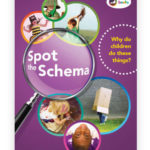Recommended Resources
Schema booklet
Posted on April 4, 2012. I have written in the past about schema. This only gave a brief overview of schema and how they relate to children’s learning.
I have written in the past about schema. This only gave a brief overview of schema and how they relate to children’s learning.
In this article I also detailed some resources and for which you can use for children to support their schemas. Since then there’s been a new booklet published by in the picture, entitled ‘Spot the Schema: why do children do these things?’
This is a lovely little booklet that explains and describes the 8 most common schemas: transporting, trajectory, transforming, enveloping, enclosing, connection, positioning and finally rotation. Each schema has a double page spread to itself, what signs to look out for and things you can do to extend learning and thinking are detailed.
For example, the trajectory schema page explains how this schema can often be seen as challenging behaviour, where children throw or kick things. However, if the child has been identified with a trajectory schema, the sorts of things that can be done to extend learning and thinking are:
Provide games such as marble run skittles.
Spray and splatter painting.
Making paper aeroplanes.
Throwing and aiming games using balls and other toys.
The sort of activities these children might enjoy could be based around rockets and spaceships.
This is really straight forward, clear advice that could be used by all practitioners.
The real beauty of this booklet is its instructions and lovely pictures that accompany them. In full colour and good production quality it is a booklet that will stand up to the ravages of time in any setting. At the back there is included a comprehensive reading list where practitioners can get further information about schema and associated items.
This booklet could be used to inform parents or during a staff meeting for practitioners. It will certainly be useful for training courses on schema to leave with practitioners for them to look at, at their own leisure.
‘Spot the schema’ is available from www.inthepicture.info/schemas.
The kind people at inthepicture gave me a free preview copy.


